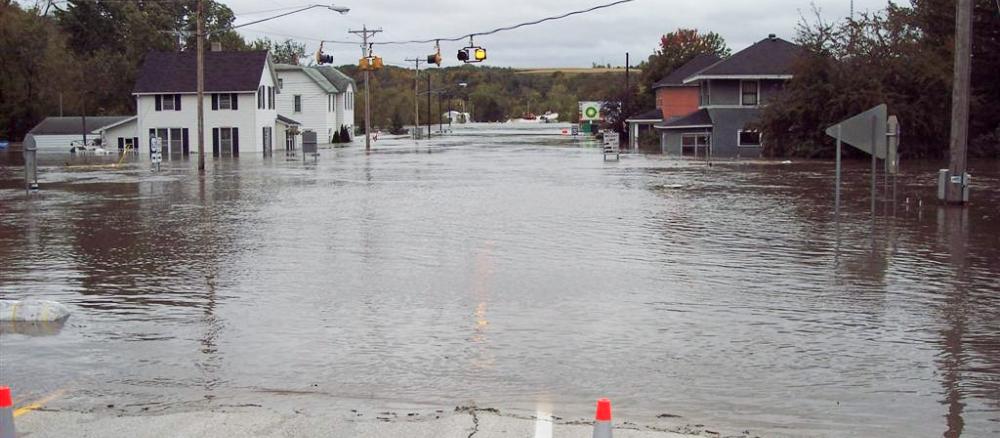Flooding conditions can be destructive in a variety of ways. One concern is hazardous materials being swept up by floodwaters and spread around, posing risks to the environment and to human health. Here are some strategies for minimizing this type of pollution and damage.
Household hazardous waste
If flooding is predicted for your community, move hazardous household products out of areas of your home that are most likely to be flooded, such as garages and basements. Take any products you no longer need to your county's hazardous waste disposal facility. Check for:
- paints, varnish, paint thinner, and furniture stripper
- batteries
- furniture polish, bleach, and spot removers
- motor oil, gasoline, and antifreeze
- weed killers, insecticides, and fertilizers
- drain, oven, and floor cleaners
- disinfectants and ammonia
- pharmaceuticals, nail polish and remover, and sharps
Move items such as vehicle batteries and propane tanks to higher ground. Keep canned goods and other foodstuff out of harm’s way. If these come in contact with flood waters, you should consider them unsafe to eat and throw them out.
Your county's environmental office will be able to provide further guidance on the disposal of household hazardous waste.
Fuel and storage tanks
If enough floodwater enters a basement, an unsecured fuel oil tank may become unstable, tip over, and/or float. If a tank’s vent, fill pipe, or other openings are not watertight, floodwater will enter the tank and displace the fuel into the basement. In addition to creating possible health, fire, and environmental hazards, the fuel will be absorbed by any porous material (wood, cinder block, carpet, and drywall) it comes in contact with. Once that happens, fuel vapors and strong odors may persist in the building indefinitely.
The best way to prepare indoor and aboveground fuel tanks for flooding is to empty them. Your bulk fuel distributor can empty the tank and plug its vent and fill pipes. If it's not possible or practical to empty a tank, it should be secured to concrete anchors or deadmen in the ground so it can't tip or float away. Valves to hoses or dispensers should be securely closed. Strap indoor tanks down to ensure they stay upright in floodwaters.
Floodwater can also enter underground tanks, pushing the fuel out. Underground tanks should be topped off and their vents and fill openings should be sealed so the tanks are watertight. Another option is to remove the tank contents and fill the tank with water because an empty or partially full tank can become buoyant and pop out of the ground. Shear valves on commercial underground tanks should be closed or "tripped" and power should be shut off to the system in the event of flooding. Shutting off the power prevents fuel from leaving the system if floating debris knocks over a dispenser.
If your tanks become damaged or leak, call the Minnesota Duty Officer at 651-649-5451 or 800-422-0798. The MPCA can help tank owners arrange for cleanup, and the Minnesota Department of Commerce may reimburse most of the costs of a fuel cleanup.
Manure storage
Divert water from manure-storage facilities, if possible, to reduce the risk of an overflow. Remove manure stockpiles in areas that could be flooded. Contact the Minnesota Duty Officer immediately at 651-649-5451 or 800-422-0789 if your manure storage structure overflows or is inundated by flood waters or if manure enters a lake, river, stream, or wetland.
Industrial hazardous wastes
If your business works with hazardous materials and hazardous wastes, take steps to prepare for potential flooding. Make sure that drums and other containers are closed, secured, leakproof, and stored away from potential flooding areas. Make sure waste containers have labels with the contents and are marked "hazardous waste." If possible, contract for the proper disposal of hazardous waste before flooding begins.
Contact the Minnesota State Duty Officer at 651-649-5451 or toll-free at 800-422-0798 to report spills of hazardous materials and wastes.
Additional guidance
- Disasters and emergencies: Preparing and responding (MDH) - Cleanup and health tips for homeowners and businesses
- Stream flow conditions (U.S. Geological Survey) - Daily updates on stream and river flooding conditions in Minnesota.
- MnWARN is a statewide water/wastewater agency response network of “utilities helping utilities.” Members assist each other with emergency response and resources.
- Local government disaster preparedness
